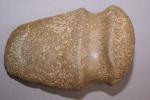By Dennis West – Back in the days when Pat Howden was a heavy drinker, his Indian name could have been Old Crow or Wild Turkey. But after he quit drinking, and smoking three packs of cigarettes a day, suddenly in the 1970s, it could have been Cold Turkey.

Howden, who lives in Harvard, Ill., has been a U.S. Marine, grocery clerk, worked for Dean Foods, a housepainter and a world record holder in repetitive weight lifting. Both his father, who died when Howden was 11, and his uncle, collected Indian artifacts in the Twin Lakes area. It was sometime before Pat stopped drinking that he began to take an interest in the cigar boxes full of arrowheads and other Indian artifacts. He says it took him two years of searching before he found his first artifact, and then he found two in one day. That got him really excited and today, along with metal detecting, artifact collecting has become an all-consuming hobby.
Howden took his 1,700-piece collection to Geneva Ridge on Sunday, Oct. 13. His pride in the artifacts was apparent as he explained them to the many people who came to see his free exhibit and share their interest with him.
Howden, who has found approximately 1,200 pieces since he began, and 64 pieces so far this year, says the best time to look is in the spring and late fall, but that doesn’t stop him from searching during the rest of the year. He says the best time to look is on a cloudy day when there are no bright areas and shadows to obscure the flint pieces whose shapes he has gotten so he can easily recognize.
He explained to visitors how Native Americans used clay ovens, some pieces of which are in his collection, to break down the structure of the flint so that it could be worked more easily. The tool maker generally kept the stone in the oven for 24 hours before he began to work it.
Among the artifacts on display were a sizer, which is a rock with a groove in it that the toolmaker used to shape, size and sharpen arrowheads.
A rock with a shallow hole in it was used to start fires. The user would place some tinder into the hole, insert a stick and work it back and forth with a bow until it generated enough friction and heat to light the tinder. Howden says he has never seen anyone use such an implement successfully and would be fascinated to do so.
Howden explained that some perfectly-rounded stones in his collection were used to play a game of kickball and/or as missles thrown with a sling as a weapon.
Many of the hundreds upon hundreds of arrowheads in his collection have striations along their sides that make them sharp enough to easily cut paper. These were painstakingly put there by the toolmaker, who learned his craft from an early age.
He has a great many pre-forms – pieces of flint that are in some early stages of preparation. One of his displays consists of five pieces that show the stages of the arrowhead-making process.
He has spent a tremendous amount of time identifying and dating his specimens, most of which are labeled with dates that stretch from the paleolithic period around 14,000 BC to a few hundred years ago. He has two copper arrowheads that were crafted by the copper-mining tribes of Michigan. One is shaped like a traditional arrowhead and the other is cone-shaped to fit over the end of an arrow, much like a target arrow one would buy in a sporting goods store today.
“Arrowheads have different shapes and manufacturing techniques that changed over time,” he says. “He has used books to research when the artifacts were made, then mounted them on felt-covered board and attached the dates when they were made.
Most of Howden’s arrowheads are between 3,000 and 5,000 years old. His searches are usually confined to the area around Big Foot Prairie and Sharon, though he declines to be more specific.
“Any stone that is shiny is a chip or flake from a bigger piece,” he explains. “Smaller arrowheads were used to hunt birds, while the larger ones were used for bigger game. Anything longer than three inches was a lance, or spear, point.”
He has a few axe heads and some pieces of pendants with holes drilled in them to insert a rawhide strand.
“The pendants were usually broken after the wearer died,” he explains, “so it would be very rare to find a whole specimen.”
Howden says he enjoys metal detecting, too. He has found more than 300 gold rings in his searches. One of his most interesting finds was a 1920 class ring.
Lake Geneva History Museum director (name) stopped at Geneva Ridge to ask Howden if he would present a program at the museum in the coming months. Always happy to share his discoveries with others, Howden said he would be happy to do so.
